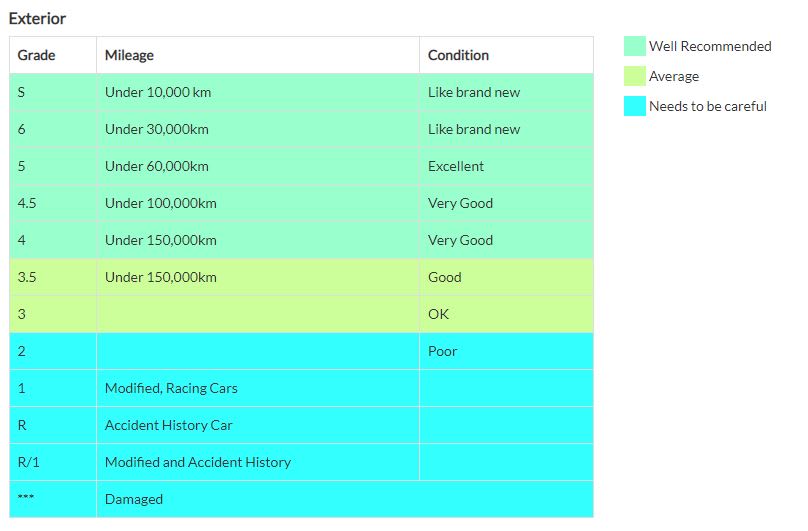What is Japanese auction sheet | How to understand Japanese car's Auction Grade | Japanese Auction Grading System

What is a Japanese Auction Sheet?
Japanese auction sheets are vital in purchasing used cars from Japan and are typically the initial focal point for evaluating a potential acquisition. These sheets are created by professional inspectors hired by the auction house and provide a detailed summary of the vehicle's condition and history. They contain important information such as:
- Chassis number
- Initial registration date of the vehicle in Japan
- History of crash repairs
- Evaluation of dents or scratches on the vehicle, categorized by severity
- Presence of rust or corrosion
- Interior condition
- Any engine noise or transmission issues
- Oil leaks
- Whether the vehicle has undergone respraying
Following the examination by the auction house, the vehicle undergoes a classification process assigning a distinct "Grade" for its interior and exterior conditions, ultimately resulting in an overall grade. Specifics regarding auction grades are provided below.
While auction sheets offer a valuable overview, depending entirely on them poses significant risks. Our team in Japan and Bangladesh consistently conducts hands-on inspections of our cars, a pivotal practice in guaranteeing that our customers receive vehicles of the utmost quality.
Auction Grade And Details:
Auction Grade and details are listed below:
- S Grade: Less than 12 months old from the initial registration date and with mileage below 10,000km. Exhibits a condition comparable to that of a new vehicle. Both the exterior and interior are in flawless condition.
- 6 Grade: Less than 36 months old from the first registration date and with mileage under 30,000km. Represents a very recent model and is nearly indistinguishable from new.
- 5 Grade: The car has a mileage under 50,000km. While the exterior may display some extremely minor scratches, scrapes, or dents, this grade is challenging to achieve. It is in near-perfect condition with only minimal imperfections.
- 4.5 Grade: The vehicle has a mileage under 100,000km. Once again, a highly commendable grade. While there may be slight imperfections in the bodywork, major repairs are unnecessary.
- 4 Grade: With a mileage under 150,000km, the exterior might have some scratches, scrapes, and dents. Overall, the car is in above-average condition, free of crash history. It may require minor repairs.
- 3.5 Grade: The exterior exhibits noticeable large scratches, scrapes, or dents, possibly necessitating minor bodywork or painting. The car maintains an average condition considering its year and mileage.
- 3 Grade: The exterior showcases numerous prominent scratches, scrapes, paint blemishes, and/or large dents, likely requiring significant bodywork and/or painting.
- 2 Grade: The vehicle is in very poor overall condition, making it advisable to avoid it, as serious corrosion issues are common.
- 1 Grade: The car possesses one or more of the following issues: [Additional details not provided]
- The vehicle that exhibits one or more of the following characteristics:
- Installation of an aftermarket turbo
- Conversion from an automatic transmission to a manual transmission
- Incurred flood damage
- Suffered damage from a fire extinguisher
- RA. The vehicle that has experienced accident damage is categorized as MINOR and has undergone subsequent repairs.
- R. The vehicle that has sustained accident damage and has undergone the necessary repairs. According to auction terminology, a "car with accident damage" refers to a vehicle that has incurred damage to the following areas: Lower Tie Bar or Frame, Windshield Pillar (A-Pillar), Centre Pillar (B Pillar), Rear Pillar (C Pillar), Strut Housing, Roof Panel, Trunk floor Pane, and Floor Pan.
- *** The vehicle has undergone significant accident damage and remains unrepaired. Alternatively, a car with a non-functioning engine due to severe engine troubles.

Interior Code Details:
- A. No repairs are required, and the vehicle is in a new or nearly new condition.
- B. Minor repairs are not needed, and the interior is exceptionally clean.
- C. Repairs are necessary, and the vehicle may exhibit some of the following issues: tears, cigarette burn marks, worn patches, visible open screw holes, dashboard warping, or small tears on the dashboard. Alternatively, the interior may be dirty and in need of cleaning.
- D. Major repairs are necessary, and the vehicle may display several cigarette burn marks in the interior, a significantly warped dashboard, a dirty interior, or missing parts. Even after cleaning, some dirty patches may persist. Substantial work is required.
- E. Major repairs are necessary, and the vehicle may have a dashboard with major tears, a very dirty interior with significant tears, a flattened interior, or an unpleasant odor. Significant attention and restoration work are essential.

Auction Sheet Abbreviations:
Auction sheet abbreviations are given below:
- AC Air conditioner
- FA/AT Automatic transmission
- F5 Manual (5-speed) transmission
- PS Power steering
- SR Sunroof
- AW Original alloy wheels
- NAVI Navigator
- AAC Climate control air conditioner
- CA Column automatic transmission
- F6 Manual (6-speed) transmission
- PW Power windows
- TV Television
- KAWA Leather seats
- AIRBAGU Airbag
Note: Sometimes there are marks beside the mileage place:
- " $ " means that the odometer has been replaced but it is true mileage
- " * " means that is not true mileage
- " # " means that is unknown mileage

Meaning of the Inspection Sign in the Auction Sheet
These are the meanings of the signs which are found in the auction sheet provided by the auction house inspector:
- A1 - Small Scratch
- A2 - Scratch
- A3 - Big Scratch
- E1 - Small Dent
- E2 - A Few Small Dents
- E3 - Many Small Dents
- U1 - Small Dent
- U2 - Dent
- U3 - Big Dent
- B1 - A small defect on the bumpers (about the size of your thumb)
- U3 - A noticeable defect on bumpers
- W1 - Repair Mark/Wave (hardly detectable)
- W2 - Repair Mark/Wave
- Y1 - Small Hole or Crack
- Y2 - Hole or Crack
- Y3 - Big Hole or Crack
- S1 - Rust
- S2 - Heavy Rust
- C1 - Corrosion
- C2 - Heavy Corrosion
- X - The element needs to be replaced
- XX - Replaced element
- R - Repaired Crack on the Windshield
- RX - Repaired Crack on Windshield (needs to be replaced)
- G - Stone Clips in glass
So please do not worry if you find it hard to understand the auction sheet.
For Auction Sheet Verification: https://carmodsbd.com/auction-sheet-verification



